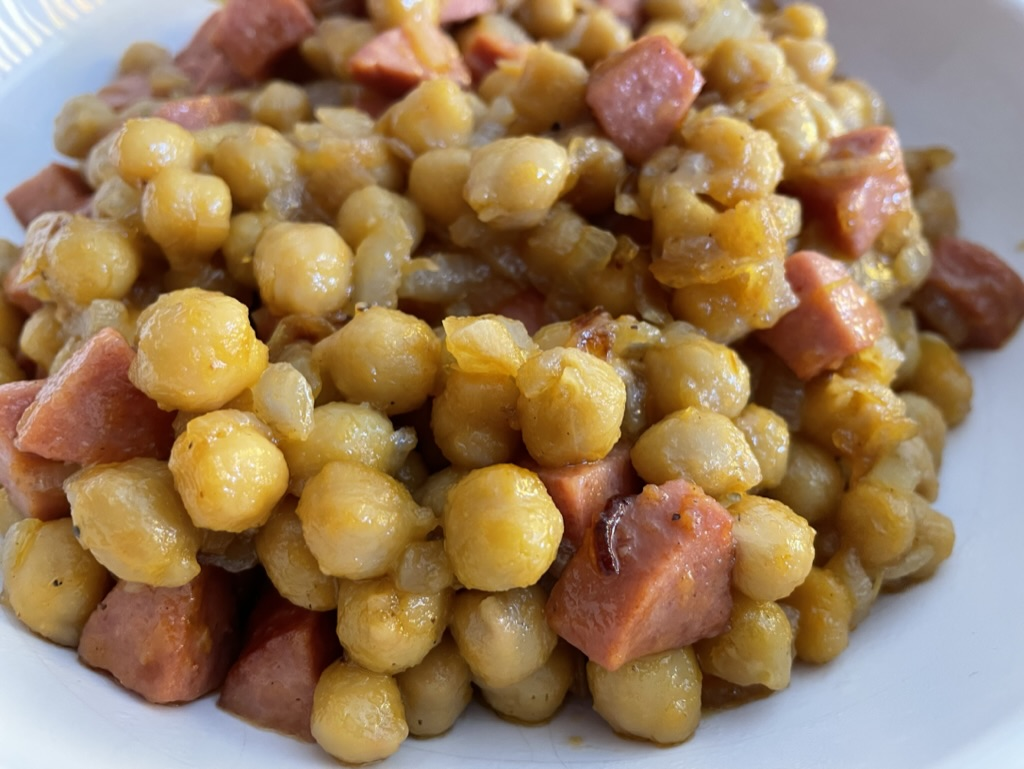The paella is a staple of Spanish cuisine, more specifically, the Mediterranean coast. It’s become wildly popular, so multiple versions have been created to accommodate to all tastes, especially tourists: paella with chorizo, with too much seafood, and other disasters. To each their own, it’s positive that people love the dish so much that they venture into those extreme modifications, but they are missing on the great dish with subtle tastes that is a traditional paella.
Therefore, if you want to prepare a basic “core” paella, this is a pretty decent version with stuff you can have in your fridge. I’ll mention the modifications I made from the traditional recipe, and how you can substitute ingredients for other food you can find in your local market.
The dish is quite easy (fry meat, fry vegetables, add rice and cover with stock), but getting the perfect cook point takes experience.
Use one pan and one fat source for everything - hence the name “paella” (“pan”), as ingredients go in and out, but the pan stays.
Fry the meat
- Stir fry the meat in a very generous amount of fat. The pan should be fully covered in 5-10 mm of fat. The recommended fat source is olive oil. Alternatively, sunflower oil, canola oil, or lard. Never use butter. Salt and pepper to taste, but don’t add too much, we’ll rectify it at the end.
- About the meat type. The traditional paella uses rabbit and chicken, I used rabbit and pork sausage as pork provides a heartier taste. Do not abuse pork (no chorizo, no bacon, no 100% pork) unless that is specifically your goal. Classic paellas use white meat / poultry exclusively. In cultures that do not eat rabbit, use chicken. Ensure 100-150g of lean meat per serving, therefore include the raw weight of meat to account for bones.
- You can make a vegetarian paella by removing meat and adding more vegetables (for ideas, see below)
- The meat should be around 80%-90% cooked as it will finish cooking later. If in doubt, cook it fully, you don’t want raw rabbit. Once it’s done, reserve it.
Fry vegetables
- Using the same oil, stir fry onion, green or red Italian pepper (alternatively, bell pepper), and tomato. Roughly, 1 onion, 1/2 pepper and 2 tomatoes per person. Optionally, one or two garlic cloves. This is the vegetable base. The original version uses an extremely specific type of pepper called nyora. Don’t sweat it. Italian or bell.
- For added texture and body, the traditional recipe also includes lima beans and green beans, the flat type, cut in half or thirds. I included wild mushrooms (no button) and artichokes which blend in pretty well with the canonical paella.
- Make sure the onion, pepper and tomato are thoroughly cooked, as you don’t want to find hard bits in the final dish. If you use green beans, however, they should add texture, so don’t let it get too soft. Salt and pepper to taste, but don’t add too much, we’ll rectify it at the end.
Add the rice and cook it
- Add in the meat and the rice to the pan with the vegetables, and cook the rice 1-2 minutes until it starts to become transparent. Aim for 80g-100g of rice per serving. Don’t be afraid of making too much, paella becomes an excellent leftover. Just reheat it in a pain with a bit more oil.
- Use round rice, like the one used for risotto. It needs to have some starch. Never, never use basmati or long rice for a paella, it will be too dry.
- Add in the stock. I used chicken and vegetable stock. You can also use pure vegetable stock. As a last resort, use water. In that case, increase the amount of the vegetable base by 50% to compensate for the lack of flavor of water.
- The proportion of rice to stock should be around 1:2 by weight. This varies a lot depending on the type of the rice, the evaporation rate, and even weather conditions. My advice is to start with 1:1.75 and add the stock whenever needed.
- The traditional paella includes saffron, I didn’t have any.
How to tell when it’s done
- When the rice is done it will stop absorbing liquid. This usually takes 15-20 minutes. This is why it’s better to add liquid when necessary rather than dumping it all at the beginning.
- In some places there seems to be a misconception about the socarrat (sticky bits of rice). In the traditional recipe this is a by-product of cooking the rice on a wide and thin pan over a fire. It tastes nice, but it shouldn’t be the focus of the paella. Furthermore, it is very difficult to control when cooking at home at a regular kitchen with a regular pan. Just avoid it until you are an expert, otherwise instead of socarrat you will get disgusting burnt rice.
- Therefore, stir the rice very gently every 2-3 minutes to avoid it getting stuck to the bottom of the pan and undercooked.
- Taste, taste, taste. Rectify salt and pepper. If the paella lacks flavor, add in a bit of acid like the juice of 1/4 of a lemon or a bit of white wine. This is 100% non-traditional, but I think it is a reasonable modification.
- Taste the texture of the rice every 2 minutes after the 15th. When it is al dente, meaning that you could eat it but it’s still a bit hard, and a thin layer of liquid still remains (see picture) turn the heat off and let it rest for 3-5 minutes. You can cover it with a cotton cloth, but do not fully cover the pan with a lid because the rice will get soft and overcooked. It needs to breathe.
Enjoy!
That’s it! You can now enjoy the paella as spaniards eat it at home, using ingredients that are available worldwide.
Here’s the finished dish:

deleted by creator

